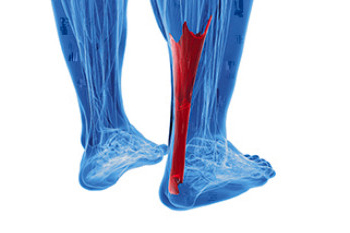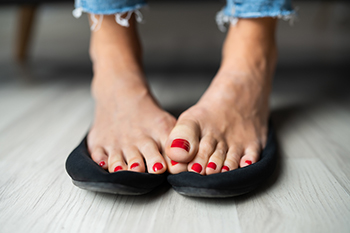Items filtered by date: October 2022
Dealing With Achilles Tendonitis

The Achilles tendon connects the heel to the bones of the leg. When it becomes irritated or swollen, inflammation may set in that causes a painful condition known as Achilles tendonitis. Other symptoms include stiffness and soreness in the heel, a crackling sound when the ankle moves, pain when the foot is extended, and weakness in the affected leg. Achilles tendonitis is common among athletes whose sport or activity puts particular stress on the heel, such as running, jumping, basketball, dancing, skiing, or figure skating. A walking boot or cast may be necessary for stability, and custom orthotics may help to keep the injury from recurring. In severe cases, surgery may be required. Seeing a podiatrist is a wise way to find out the best treatment options to combat this condition.
Achilles tendon injuries need immediate attention to avoid future complications. If you have any concerns, contact one of our podiatrists of CyFair Family Foot Care. Our doctors can provide the care you need to keep you pain-free and on your feet.
What Is the Achilles Tendon?
The Achilles tendon is a tendon that connects the lower leg muscles and calf to the heel of the foot. It is the strongest tendon in the human body and is essential for making movement possible. Because this tendon is such an integral part of the body, any injuries to it can create immense difficulties and should immediately be presented to a doctor.
What Are the Symptoms of an Achilles Tendon Injury?
There are various types of injuries that can affect the Achilles tendon. The two most common injuries are Achilles tendinitis and ruptures of the tendon.
Achilles Tendinitis Symptoms
- Inflammation
- Dull to severe pain
- Increased blood flow to the tendon
- Thickening of the tendon
Rupture Symptoms
- Extreme pain and swelling in the foot
- Total immobility
Treatment and Prevention
Achilles tendon injuries are diagnosed by a thorough physical evaluation, which can include an MRI. Treatment involves rest, physical therapy, and in some cases, surgery. However, various preventative measures can be taken to avoid these injuries, such as:
- Thorough stretching of the tendon before and after exercise
- Strengthening exercises like calf raises, squats, leg curls, leg extensions, leg raises, lunges, and leg presses
If you have any questions please feel free to contact our offices located in Cypress and Spring, TX . We offer the newest diagnostic tools and technology to treat your foot and ankle needs.
Dressing a Wound

Individuals who suffer from diabetes will sometimes develop foot ulcers, which are open sores or lesions that take time to heal. One way that a diabetic might consider managing their ulcers is by properly dressing them. The purpose of this technique is to ultimately reduce symptoms and facilitate healing. Importantly, dressings are not meant to be permanent. A diabetic patient can change these dressings on a regular and frequent basis to inspect the ulcer. There are several different kinds of dressings. For example, one might opt to use non-adhesive dressings, foam and alginate dressings, and hydrogels. However, whichever dressings a diabetic chooses will be largely dependent on their needs and the peculiarities of their ulcers. Contact a podiatrist today for more information.
Wound care is an important part in dealing with diabetes. If you have diabetes and a foot wound or would like more information about wound care for diabetics, consult with one of our podiatrists from CyFair Family Foot Care. Our doctors will assess your condition and provide you with quality foot and ankle treatment.
What Is Wound Care?
Wound care is the practice of taking proper care of a wound. This can range from the smallest to the largest of wounds. While everyone can benefit from proper wound care, it is much more important for diabetics. Diabetics often suffer from poor blood circulation which causes wounds to heal much slower than they would in a non-diabetic.
What Is the Importance of Wound Care?
While it may not seem apparent with small ulcers on the foot, for diabetics, any size ulcer can become infected. Diabetics often also suffer from neuropathy, or nerve loss. This means they might not even feel when they have an ulcer on their foot. If the wound becomes severely infected, amputation may be necessary. Therefore, it is of the upmost importance to properly care for any and all foot wounds.
How to Care for Wounds
The best way to care for foot wounds is to prevent them. For diabetics, this means daily inspections of the feet for any signs of abnormalities or ulcers. It is also recommended to see a podiatrist several times a year for a foot inspection. If you do have an ulcer, run the wound under water to clear dirt from the wound; then apply antibiotic ointment to the wound and cover with a bandage. Bandages should be changed daily and keeping pressure off the wound is smart. It is advised to see a podiatrist, who can keep an eye on it.
If you have any questions, please feel free to contact our offices located in Cypress and Spring, TX . We offer the newest diagnostic and treatment technologies for all your foot care needs.
Understanding Why Your Feet Sweat

Sweating, or perspiring, is a natural way that the body controls its temperature to keep it from getting too hot. However, some people have overactive sweat glands, which is a condition known as hyperhidrosis. The cause is largely unknown, but thought to be related to genetics. In some cases, underlying medical conditions may be a cause. Hyperhidrosis is more common in younger men than in women. One of the places where this condition can present particular problems is in the feet. They can get slippery within the shoes, which breaks down the skin and allows infections to develop. Foot odor may occur, causing social embarrassment and stress. If your feet sweat excessively, it is a good idea to consult a podiatrist for help in controlling the condition. Among the options for combating sweaty feet are antiperspirants, botox injections, oral medication, and in certain cases surgery to remove the sweat glands.
If you are suffering from hyperhidrosis contact one of our podiatrists of CyFair Family Foot Care. Our doctors can provide the care you need to attend to all of your foot and ankle needs.
Hyperhidrosis of the Feet
Hyperhidrosis is a rare disorder that can cause people to have excessive sweating of their feet. This can usually occur all on its own without rigorous activity involved. People who suffer from hyperhidrosis may also experience sweaty palms.
Although it is said that sweating is a healthy process meant to cool down the body temperature and to maintain a proper internal temperature, hyperhidrosis may prove to be a huge hindrance on a person’s everyday life.
Plantar hyperhidrosis is considered to be the main form of hyperhidrosis. Secondary hyperhidrosis can refer to sweating that occurs in areas other than the feet or hands and armpits. Often this may be a sign of it being related to another medical condition such as menopause, hyperthyroidism and even Parkinson’s disease.
In order to alleviate this condition, it is important to see your doctor so that they may prescribe the necessary medications so that you can begin to live a normal life again. If this is left untreated, it is said that it will persist throughout an individual’s life.
A last resort approach would be surgery, but it is best to speak with your doctor to find out what may be the best treatment for you.
If you have any questions please feel free to contact our offices located in Cypress and Spring, TX . We offer the newest diagnostic and treatment technologies for all your foot and ankle needs.
Clubfoot Affects Males More Than Females

One of the more common congenital foot conditions is known as clubfoot. It develops while the baby is in utero and cannot be treated until birth. The tendons that connect the heels to the leg muscles are too short, and this may result in clubfoot. Research has indicated it affects males more than females, and it can be seen in approximately one out of 1,000 births in the United States. It is beneficial that treatment begins early in the baby’s life, preferably within two weeks of birth. The type of treatment can range from using manual manipulation that may help to move the feet into a normal position, to possibly having surgery performed. In many cases, the child can begin regular sports activities when of age after the preferred method of treatment. Common signs of clubfoot include the foot turning in and downward, with the toes pointing toward the opposite foot. Additionally, the affected foot, heel, and calf muscles may be smaller than the other foot, but the foot may straighten out as the healing process occurs. If you would like more information about clubfoot, please confer with a podiatrist who can answer any questions you may have and address your concerns.
Congenital foot problems require immediate attention to avoid future complications. If you have any concerns, contact one of our podiatrists of CyFair Family Foot Care. Our doctors can provide the care you need to keep you pain-free and on your feet.
Congenital foot problems are deformities affecting the feet, toes, and/or ankles that children are born with. Some of these conditions have a genetic cause while others just happen. Some specific foot ailments that children may be born with include clubfeet, polydactyly/macrodactyly, and cleft foot. There are several other foot anomalies that can occur congenitally. What all of these conditions have in common is that a child may experience difficulty walking or performing everyday activities, as well as trouble finding footwear that fits their foot deformity. Some of these conditions are more serious than others. Consulting with a podiatrist as early as possible will help in properly diagnosing a child’s foot condition while getting the necessary treatment underway.
What are Causes of Congenital Foot Problem?
A congenital foot problem is one that happens to a child at birth. These conditions can be caused by a genetic predisposition, developmental or positional abnormalities during gestation, or with no known cause.
What are Symptoms of Congenital Foot Problems?
Symptoms vary by the congenital condition. Symptoms may consist of the following:
- Clubfoot, where tendons are shortened, bones are shaped differently, and the Achilles tendon is tight, causing the foot to point in and down. It is also possible for the soles of the feet to face each other.
- Polydactyly, which usually consists of a nubbin or small lump of tissue without a bone, a toe that is partially formed but has no joints, or an extra toe.
- Vertical talus, where the talus bone forms in the wrong position causing other bones in the foot to line up improperly, the front of the foot to point up, and the bottom of the foot to stiffen, with no arch, and to curve out.
- Tarsal coalition, when there is an abnormal connection of two or more bones in the foot leading to severe, rigid flatfoot.
- Cleft foot, where there are missing toes, a V-shaped cleft, and other anatomical differences.
- Macrodactyly, when the toes are abnormally large due to overgrowth of the underlying bone or soft tissue.
Treatment and Prevention
While there is nothing one can do to prevent congenital foot problems, raising awareness and receiving neonatal screenings are important. Early detection by taking your child to a podiatrist leads to the best outcome possible.
If you have any questions please feel free to contact our offices located in Cypress and Spring, TX . We offer the newest diagnostic tools and technology to treat your foot and ankle needs.
